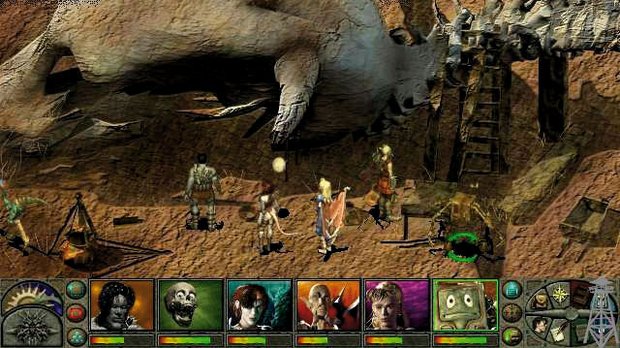Celebrating Planescape Torment's oddball approach
Start at the end. That was the first step in Black Isle’s plan, to take the ever-popular Advanced Dungeons & Dragons (AD&D) framework and use it to shape a truly out of the ordinary role-playing experience. Beginning with you laid out dead on a mortuary slab. Nowadays this approach would be called something cretinous such as ‘disruptive philosophy’; back then it was just a team striving to make something unique, something memorable. And they did.

Computer and console games grown from the fertile soil of Dungeons & Dragons, enriched by the blood of heroes and the terrible faeces of wyverns, were by no means a new thing in the mid-’90s. But publisher Interplay, well known for Wasteland and The Bard’s Tale, were ready to step it up a level. Enter Black Isle Studios, a dedicated AD&D developer set up to keep those RPG good times rolling.
AD&D’s Planescape setting also arrived around this time, expanding the Manual of the Planes sourcebook into a full-blown world of realm-hopping grit and grandeur. After the release of Black Isle’s Fallout 2 in 1997, the studio and this new setting coincided with a cosmic bro-fist; the resulting title, Last Rites, fair sizzled with ambition. That game became Planescape: Torment and launched in the last months of the millennium, bowling over critics, blowing away RPG fans and... not selling colossally well. But in terms of sealing a reputation, it was hard to beat.

Torment gave new purpose to familiar AD&D rules with the promise of otherworldly expeditions, immersing players in the enigma that was the life – or lives – of the Nameless One, a man-sized bundle of scars and snarls prone to losing his memory in that inconvenient dead bit between incarnations. This journey led players through the crossroads city of Sigil and out across the planes, but there was no world-endangering lunatic to chase down, no superweapon to decommission or bleating VIP to rescue; just the jigsaw of one man’s (admittedly barking mad) existence to piece back together.
The cursor-driven gameplay was typical of the Infinity Engine that pumped thrumming RPG power into many Black Isle and BioWare games of that era. But the overwhelming focus on story was something new. Memories and discoveries fed both into and out of a river of branching gamebook-style interactions. Torment was graced with one of the most well-written and thought-provoking stories of any RPG.

While Black Isle’s later Icewind Dale adventures put action first, Torment’s love of words was obvious and contagious. It put the story at the heart of the game and had the courage of its convictions to the last breath – a vital title to look back on as gaming narrative finds its feet in this generation.
Despite that, the fact that a spiritual successor took this long (and only came via crowdfunding) is an indictment of today’s big business focus group mentality, its fixation on the ‘mythical mass market’ dismissed by Interplay and inXile founder Brian Fargo in the video for 2014’s Torment: Tides of Numenera. Encouragingly, this all-new Torment hit its Kickstarter goal in record time, luring back original talent such as designers Chris Avellone and Colin McComb. So with its predecessor’s strengths stamped onto gaming history, maybe some play-it-safe publishers will now watch and take note of what can be accomplished with games to make them worth remembering years down the line.
Weekly digests, tales from the communities you love, and more
Click here for more excellent GamesMaster articles. Or maybe you want to take advantage of some great offers on magazine subscriptions? You can find them here.



